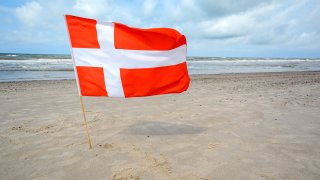
- The scale of the project, which will be located in waters 80 kilometers off the coast of the Danish mainland, is considerable.
- The first phase will involve approximately 200 offshore wind turbines.
Denmark is to push forward with plans to build a huge artificial island in the North Sea that will act as a major renewable energy hub and cost billions of dollars to develop.
The Danish Energy Agency, part of the government's Ministry of Climate, Energy and Utilities, said Thursday the project would be owned by a public-private partnership, with the Danish state holding a majority stake.
The scale of the project, which will be located in waters 80 kilometers off the coast of Jutland, the large peninsula which contains the Danish mainland, is considerable.
The first phase — set to have a capacity of 3 gigawatts (GW) — will involve approximately 200 offshore wind turbines sending electricity to the hub, which will distribute it to nearby countries via the grid.
In future, the capacity of the hub could be expanded to 10 GW. This, Danish authorities say, would be enough to power 10 million homes in Europe. Depending on its final capacity, the island will cover an area between 120,000 and 460,000 square meters.
The estimated cost of building the artificial island, 10 GW of capacity and required transmission grid will amount to 210 billion Danish krone ($33.97 billion).
"The energy hub in the North Sea will be the largest construction project in Danish history," Dan Jørgensen, the Danish minister for climate, said in a statement.
Money Report
"It will make a big contribution to the realization of the enormous potential for European offshore wind, and I am excited for our future collaboration with other European countries," he added.
The project will now move forward, with Denmark's climate department entering into discussions with potential investors from the private sector. On the political front, conditions of the tender will be negotiated, new legislation passed and environmental impact assessments carried out.
In addition to the artificial island, a second energy hub of 2 GW is also being planned for the island of Bornholm, in the Baltic Sea.
Denmark is something of a pioneer when it comes to offshore wind projects. The world's first offshore wind farm, in waters near the Danish island of Lolland, was commissioned by Orsted — the company formerly known as DONG Energy — in 1991. Other Danish firms, such as turbine maker Vestas, are major players in wind power.
Looking further ahead, the European Union — of which Denmark is a member — wants its offshore wind capacity to hit 60 GW by 2030, and 300 GW by the middle of the century.






